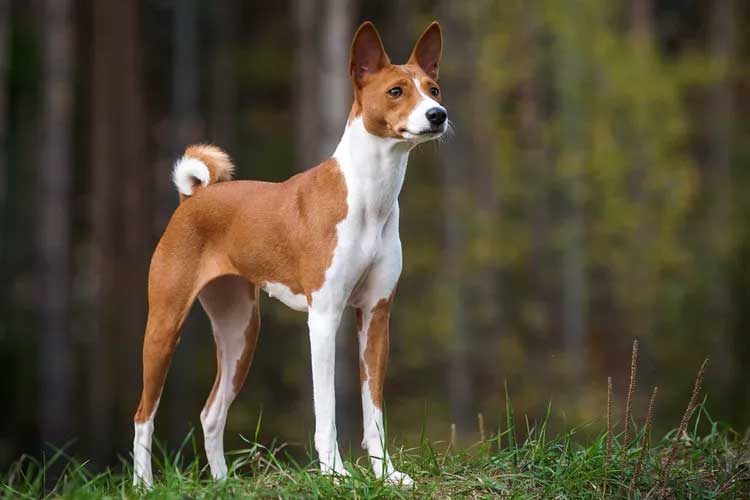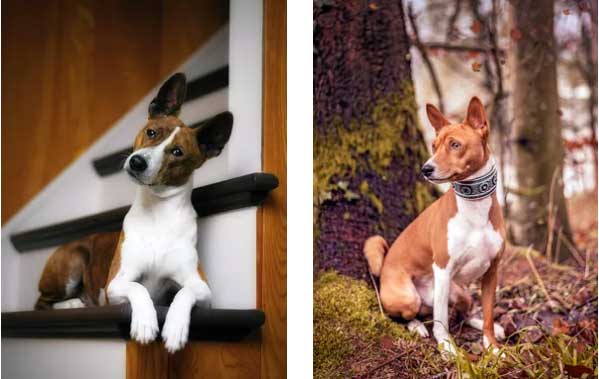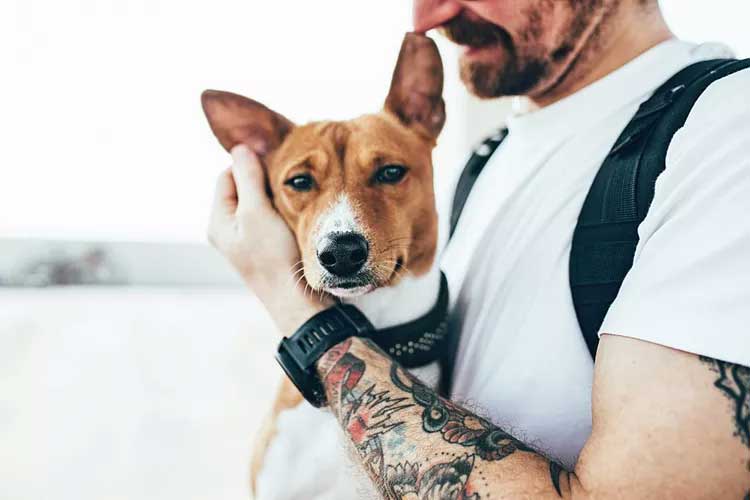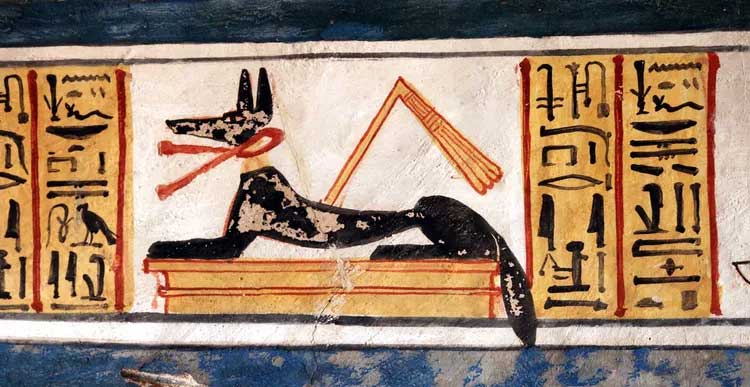Basenjis are an energetic, clever breed with adorably furrowed brows, a strong hunting drive, and an independent personality. Learn more about living with Basenjis.

Basenji Overview
| OFFICIAL NAME | Basenji |
| COMMON NAME | Basenji |
| PET HEIGHT | 16 to 17 inches |
| PET WEIGHT | 22 to 24 pounds |
| LIFESPAN | 13 to 14 years |
| GOOD WITH | children, dogs, families |
| TEMPERAMENT | aloof, friendly, gentle, playful, willful |
| INTELLIGENCE | high |
| SHEDDING AMOUNT | occasional |
| EXERCISE NEEDS | high |
| ENERGY LEVEL | hyper |
| VOCAL LEVEL | when necessary |
| DROOL AMOUNT | low |
| BREED GROUP | hound |
| BREED SIZE | small (0-25 lbs.) |
| COAT LENGTH | short |
| COLORS | black, red, white |
| PATTERNS | bicolor, brindle, tricolor |
| OTHER TRAITS | apartment-friendly, easy to groom, high prey drive, tendency to chew |
Known as the "barkless" dog, the Basenji is far from silent (search "yodeling Basenji" on YouTube—we'll wait). They're an intelligent, clever small breed from Africa with a strong prey drive and bottomless source of energy. Though small in stature, the Basenji is strong and determined. The Basenji is happiest when tracking a scent, which makes her at high risk for wandering off. Instead of letting this pup roam free, channel her energy into canine sports, such as tracking, agility, or lure coursing.
Basenjis can be incredibly strong-willed and mischievous, requiring a great deal of patience and humor from their pet parent. This rare breed isn't for the novice dog owner, but if you're up to the challenge, read on to learn more about the Basenji.
Appearance
The Basenji is a primitive hunting dog breed in a lean—yet strong—and compact size. Basenjis have alert, pointed ears, almond-shaped dark hazel or dark brown eyes, and a bushy tail that tightly curls up against her back. Wrinkles on their forehead give these pups an adorable expression of concern.
Their short coat is fine in texture and comes in four main colorways recognized by the American Kennel Club: chestnut red, black, tricolor (black, tan, and white), or brindle (black stripes on a chestnut base). Regardless of color, all Basenjis have a clearly delineated white chest, feet, and tail tip.
Basenjis are low-shedding and require very little maintenance. In fact, Basenjis are very cat-like, spending much of their down time grooming themselves. Due to this fastidious grooming, they typically don't have that "dog" smell and won't need frequent baths (lucky for you—it's common for Basenjis to hate being wet). It's still recommended to brush your Basenji weekly and give her the occasional bath when she's exceptionally dirty. The Basenji Club of America published this helpful guide of best practices for grooming a Basenji.
Temperament
Bred to be alert for long hunts through the African wilderness, Basenjis are an extremely energetic and intelligent breed that requires plenty of daily strenuous exercise and mental stimulation. Basenjis are independent thinkers known for their willful, clever, mischievous personalities."Basenjis are smart, they're active, and you need to understand how they learn," says Brian Kilcommons, founder of The Great Pets Resort, a boutique training facility in Connecticut. "Out of all the dogs, they're the most cat-like. And there's a saying: With dogs you give commands, with cats you make suggestions. Well, that's not far off from the Basenji."

Instead of a traditional yip or yelp, the Basenji makes a sort of yodeling noise. (Adorable or annoying? We'll let you be the judge.) Though it may not ward off intruders—they're much too small to be intimidating—your Basenji will probably sound the alarm when they see anything they think is suspicious, whether that be the delivery person or a passing squirrel.
Basenjis are very playful and, despite being independent, prefer you to be within sight at all times. If not properly exercised or if left alone for too long, Basenjis tend to become noisy and show undesirable behaviors. It takes a sense of humor to live with a Basenji—owners are known to jokingly brag about all the items their Basenjis have destroyed. The plus side is these pups will force you to keep a home free of clutter.
As with any breed, it's important to properly socialize your Basenji as a puppy. A well-adjusted Basenji can be good with cats, other dogs, and older children. It's important to teach children how to properly interact with dogs and always supervise them when playing with any animal.
Living Needs
Don't mistake a Basenji's independence for a desire to be alone. These hunting dogs prefer to keep their owners in sight, and though they may not snuggle up on your lap, they'll let you know when they want some attention. This high-energy breed needs plenty of exercise and is best suited to a house with a well-fenced yard—and owners should always keep an eye on them when outdoors. "They're escape artists. No fence is too high that they can't climb," Kilcommons says.With their small size and clean coats, a well-exercised Basenji can be a good fit for apartment life—just don't leave her alone for too long, as this breed is known to become noisy.
"'Oh, they're barkless!' Well yeah, that's true, but they yodel and they scream," Kilcommons says. Having another pet in the house will help satisfy this pack dog's need for company.
Basenjis have an acute sense of smell and a strong prey drive. If not properly secured, there's no question about it: they will give chase.

"If there's a squirrel around and your Basenji is off-leash, you can watch his tail go over the horizon," Kilcommons says. "Have there ever been off-leash Basenjis? Yeah, but they're the exception, not the norm. It's doable, but it takes a lot of work."
Instead of heading to the dog park, channel a Basenji's energy and prey drive into canine sports, such as tracking, agility, and lure coursing. Getting involved in these sports is a great way to physically and mentally exercise a Basenji, and build a bond to boot.
You're sure to have plenty of entertainment with a Basenji in the home. These petite pups have big personalities! Basenjis are a best fit for an owner looking to spend quality time with their dog and who has quick access to the outdoors, or with someone who's interested in getting involved in dog sports.
It's important to consider your lifestyle before committing to any dog. Talk to a Basenji breeder or rescue group about expectations to see if a Basenji is a good fit for you.
Care
Basenjis are fastidious when it comes to self-care and, much like cats, will spend hours grooming themselves, making them a very low-maintenance breed. This means fewer baths and minimum brushing—just once a week should keep your Basenji's skin healthy and coat looking sharp.
Regular brushing is a good time to check for things like coat sheen (dull hair can mean a lack of nutrients in her diet), nail length, and ear and dental health. Nails should be trimmed if you can hear them tapping against the floor. Basenjis' ear canals should be pale pink with very little—and fairly odorless—wax. Be sure to look for any signs of movement (mites!) and foreign objects in the canal. A Basenji's teeth should be brushed often. A thorough home health check-list is important, but remember, this doesn't replace a visit to the vet. Always reach out to your vet with any concerns.
Basenjis are smart dogs, but that doesn't mean training is simple. This clever breed requires patience, creativity, and loads of positive reinforcement when it comes to training.
"They're very sensitive," Kilcommons says. "If you're just going to correct them for what you don't like, you're probably going to have a problem—they don't tolerate a heavy hand." Kilcommons recommends giving Basenjis plenty of treats during training and making the experience as fun as possible.
Health
The Basenji is considered an overall healthy breed with a lifespan of 13–14 years. Like all breeds, the Basenji is prone to certain diseases. The Basenji Club of America, the official breed club, requires registered breeders to test for hip dysplasia, autoimmune thyroiditis, Fanconi syndrome, progressive retinal atrophy (PRA), and complete an annual thorough eye exam (owners should continue this until age 6, then every two years thereafter).Additional Basenji health issues to be aware of—and talk to your breeder or rescue league about—are:
Basenji enteropathy: An inflammatory bowel disease that causes chronic diarrhea and vomiting.
Persistent pupillary membranes (PPM): Strands of tissue in the eye. Although they typically don't affect the pup, they can sometimes interfere with vision.
Immunoproliferative small intestinal disease (IPSID): This is a dangerous condition that causes diarrhea and vomiting. Over time, the dog can become emaciated and weak. There is no cure, but treatment is possible.
Coloboma: When part of the eye doesn't develop properly.
Pyruvate kinase deficiency (PKD): A disease where the pup's red blood cells don't produce energy properly, leading to low energy levels, jaundiced skin, and, eventually, liver failure.
Of course, not all Basenjis will encounter serious health issues, but it's important to be aware of these common concerns when considering this breed. It's also important to purchase all dogs from reputable breeders who will introduce you to the dog's parents and siblings. If adopting, ask the rescue for any available health history.
History
Basenjis are a primitive hunting breed from central Africa, where they were prized for their silent nature, explosive speed, keen eyesight, and unmatched sense of smell. It's believed these dogs were brought up the Nile as presents to the pharaohs of ancient Egypt and are depicted in Babylonian and Mesopotamian art, according to the BCA, though there's debate on whether the depictions are actually of Basenjis as we know them today or of an ancestral breed. Also known as the Congo Terrier (or Congo Dog), Basenjis were used by tribesmen to drive small prey from the bush and to alert hunters of larger, dangerous predators.
The first attempt to export the Basenji breed to England in the late 1800s ended in tragedy, with the breeding pair dying soon after arrival. A second attempt in the 1920s ended in similar tragedy, according to the BCA. A dog named Bois (who became the first Basenji registered by the AKC in 1944) was brought to America and successfully bred with a female imported from the Congo.
More Basenjis were imported from Africa in the 1980s, which also introduced the brindle coloring. Though still considered rare, the breed became more popular after a Basenji starred in the 1954 film Good-bye, My Lady.
Basenjis are still used as hunting dogs in the Congo today. In the U.S., they're typically kept as family pets and are often seen competing in lure coursing or as show dogs.
Fun Facts
Basenjis are thought to be the inspiration for the image of Anubis, the Egyptian god of mummification and the afterlife.Basenjis are almost cat-like in the way they self-groom, which keeps their short-haired coat nearly odorless and clean.
Rather than a typical yip, Basenjis make yodeling noises.
In ancient times, Basenjis were brought up the Nile from central Africa as gifts for the Egyptian pharaohs.
Basenjis were used by central African tribesmen as prized hunting dogs.